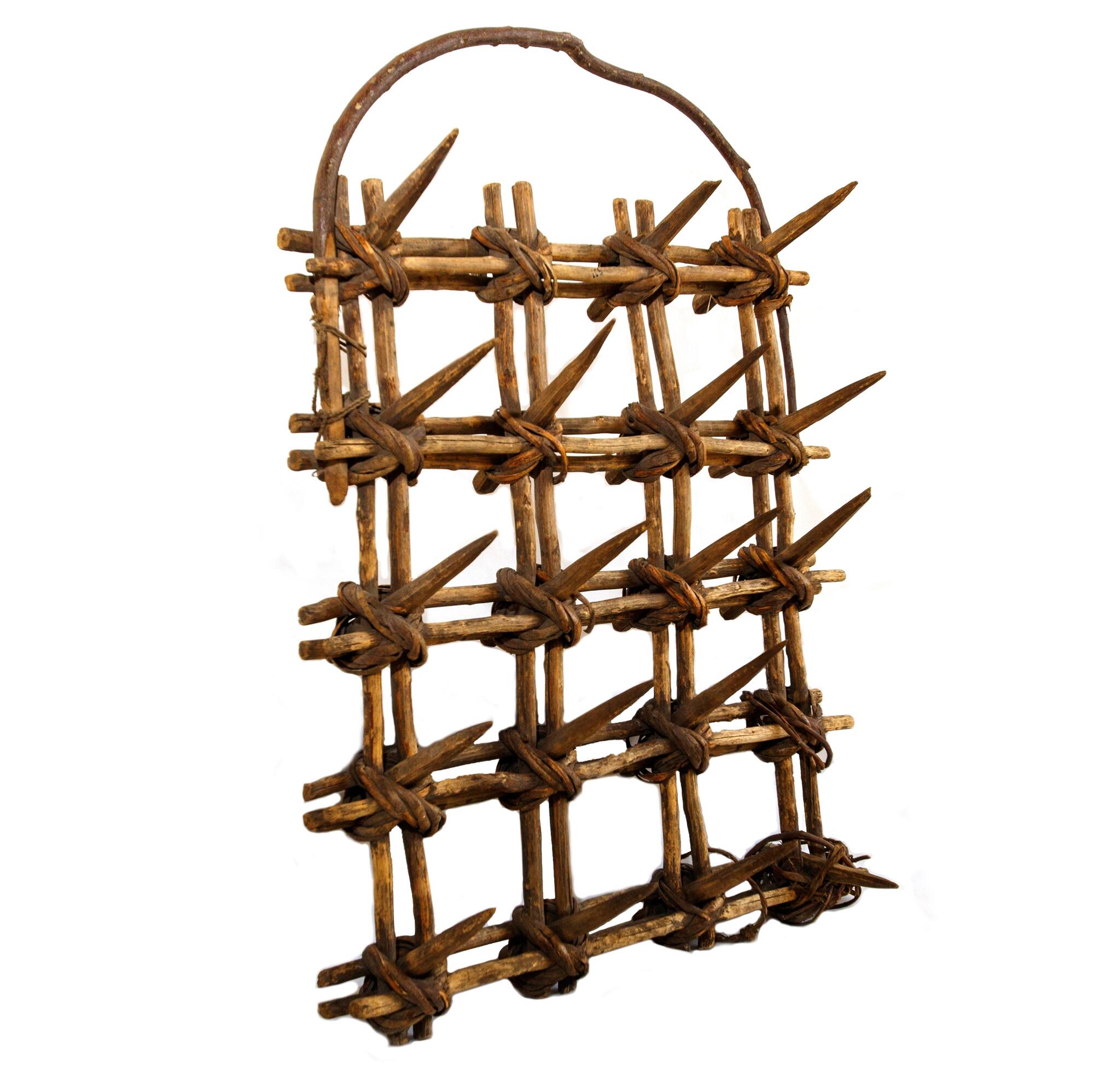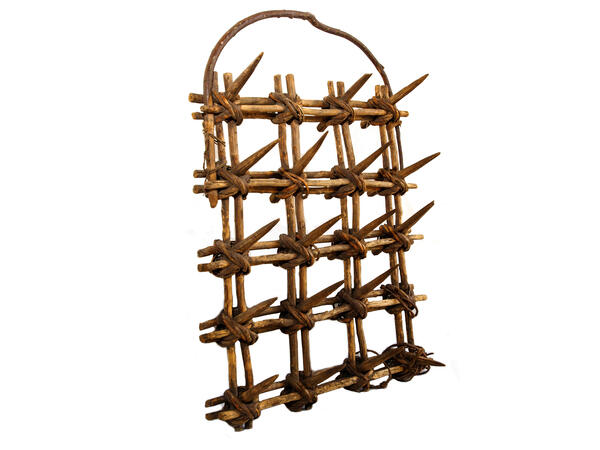The harrow (in Russian “borona”) is an agricultural tool that looks like a lattice woven from twigs by means of bast. Wooden pegs are inserted at the joints at a small distance from each other. A loop for the bent rod is attached to the front side by means of a bast and a rope.
According to one version, Russian word for harrow — “borona” — comes from the word “defense” (“oborona”). This tool helped cover seeds with earth and thus preserved crops. Harrowing kept the soil from drying out and leveled its surface. The harrow was used to loosen and mix the soil. In addition, this tool partially destroyed weeds by pulling them out by the root.
The most ancient harrow was the so called “bough harrow” in the form of connected halves of short spruce logs with long boughs. The wicker harrow presented in the exposition is its improved version. Such tool was made of a frame of spruce, birch or hazel poles with 25 to 36 pointed wooden tines, fixed by flexible bird cherry branches or split rootstock.
The tines of the front rows of the harrow were somewhat shorter than the rear ones, so that tool moved better on the ground. In addition, the load on the rear part of the harrow was greater, and the rear tines were worn out faster than the front ones. Thanks to the flexible attachment to the team poles, the harrow moved forward at an angle, not sideways, so that each tine drew a specific furrow. Sometimes a long willow twig served as a team pole, which was harnessed to the harrow without an arch.
In the old days the harrow was often used in the rituals. For example, people walked around the village with the harrow to protect it from evil. It was also believed that you could see witches, Domovoy (a house spirit) and Leshy (a tutelary deity of the forests) through the tines of the tool. There were many folk beliefs and fortune-telling associated with the harrow. It was used to “chase away” troubles and diseases and was associated with childbirth, marriage and death.
The harrow was considered a symbol of masculinity and the earth was a symbol of femininity, so it was believed that the harrow gave fertility to the earth. It was used “to call for” spring and a good harvest. Before sowing spring crops a harrow would carry a “vesnyanka” (a “spring girl”, who sings the spring songs) across the field to “carry away winter in a sleigh and bring spring in a harrow.” It was considered bad luck to pull the harrow through the village idly, because it could bring terrible disasters: plagues of livestock, fires and epidemics.
According to one version, Russian word for harrow — “borona” — comes from the word “defense” (“oborona”). This tool helped cover seeds with earth and thus preserved crops. Harrowing kept the soil from drying out and leveled its surface. The harrow was used to loosen and mix the soil. In addition, this tool partially destroyed weeds by pulling them out by the root.
The most ancient harrow was the so called “bough harrow” in the form of connected halves of short spruce logs with long boughs. The wicker harrow presented in the exposition is its improved version. Such tool was made of a frame of spruce, birch or hazel poles with 25 to 36 pointed wooden tines, fixed by flexible bird cherry branches or split rootstock.
The tines of the front rows of the harrow were somewhat shorter than the rear ones, so that tool moved better on the ground. In addition, the load on the rear part of the harrow was greater, and the rear tines were worn out faster than the front ones. Thanks to the flexible attachment to the team poles, the harrow moved forward at an angle, not sideways, so that each tine drew a specific furrow. Sometimes a long willow twig served as a team pole, which was harnessed to the harrow without an arch.
In the old days the harrow was often used in the rituals. For example, people walked around the village with the harrow to protect it from evil. It was also believed that you could see witches, Domovoy (a house spirit) and Leshy (a tutelary deity of the forests) through the tines of the tool. There were many folk beliefs and fortune-telling associated with the harrow. It was used to “chase away” troubles and diseases and was associated with childbirth, marriage and death.
The harrow was considered a symbol of masculinity and the earth was a symbol of femininity, so it was believed that the harrow gave fertility to the earth. It was used “to call for” spring and a good harvest. Before sowing spring crops a harrow would carry a “vesnyanka” (a “spring girl”, who sings the spring songs) across the field to “carry away winter in a sleigh and bring spring in a harrow.” It was considered bad luck to pull the harrow through the village idly, because it could bring terrible disasters: plagues of livestock, fires and epidemics.


